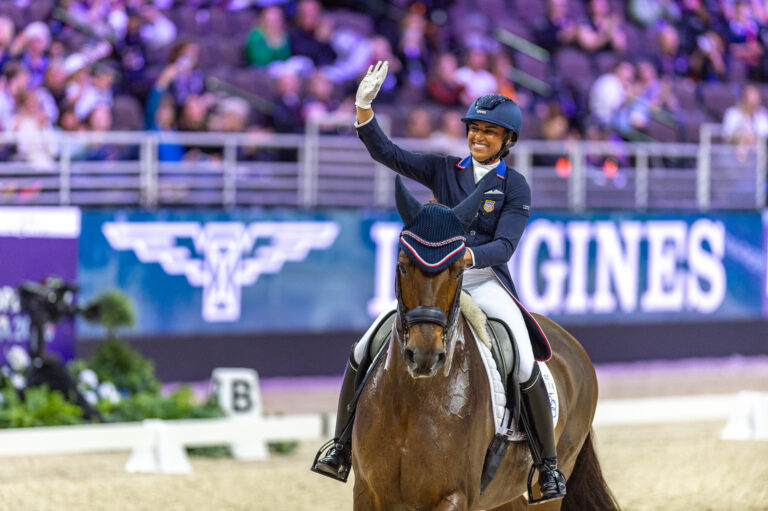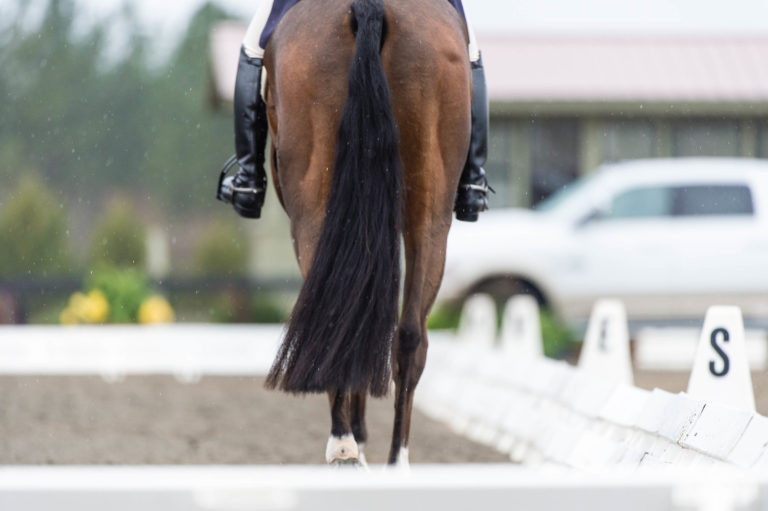Breeder Maryanna Hayman was on hand in Omaha, Nebraska to witness history she created. The beautiful Hanoverian mare Serenade MF (Sir Donnerhall/Don Principe) became the first American-bred horse to compete at the FEI Dressage World CupTM Final.
This is an event decades in the making. She and her husband Wendell, who passed away in 2021, started breeding horses in 1991. A combination of their names formed their farm, Marydell Farm, in Columbus, North Carolina.
With the goal of producing even-tempered horses capable of competing at the highest level, Hayman has accumulated her fair share of breeder awards. She has won multiple USDF Breeder of the Year awards, was named 2022 US Equestrian Breeder of the Year for dressage and was the recipient of the 2022 Ellen Scripps Davis Memorial Breeders’ Award.
She talked with Dressage Today during the FEI World CupTM Finals that took place April 5-8, 2023.
Breeding Philosophy
DT: What made you want to breed high performance horses?
MH: In 1992, I was told I was going to be in a wheelchair within two years, and I loved dressage. And so my breeding goal, which ties into your question, is I wanted to breed an adult amateur brain in an athlete’s body so when I did get to the point where I couldn’t move, a trainer would want that horse in their barn, not because I’m paying them, but because the horse was an athlete and could help them in their career or meet their goals as well. I wanted an adult amateur brain in an athletic body, so that’s what I breed for.
DT: What is your breeding philosophy?
MH: It has to, number one, have the best brain. I have to be able to handle it. I’m handicapped. There are days I walk on a walker. There are days that I walk with a cane, and there are days that I could do pretty well. But I can’t, and even back then I couldn’t, move quickly enough to get out of a horse’s way. So, the brain is the number one character.
And then work ethic. I don’t want to have to sit on a horse’s back then and push it in front of my leg, or hold it up in front, or stop it from running away. Character, work ethic, then conformation. If you have poor conformation, there are certain things you can live with and there are other things that will get you in the end. You can predict it by looking at conformation whether a horse will be willing to sit and collect. You can look at conformation and say that a horse with a good brain and work ethic will overcome all of that.
DT: What are some of the conformation traits that you zone in on and look for?
MH: I want a medium to short back. Long backs are very difficult. They’re usually weak in the loin, and they can’t sit well, or they are so big that they have different mechanics from the front end. But again, a horse that has the work ethic will figure it out.
Too short of back, then in your extensions, they may be forging or clipping themselves. But again, a horse that is trained properly and gymnasticized can overcome that one a lot easier than a long back.
The one confirmation flaw I won’t live with is base narrow. That’s where they come out of the chest pretty normally down to the knee. From the knee down, they almost touch at the hoof. My very first broodmare was base narrow. We could never keep her sound. She gave me good babies, but I always chose stallions that were very broad chested.
I like a medium to longer neck over a short neck because a short neck is hard to control. I like a quick hind leg, so a lot of my horses have jumper blood in them. But I like that in the second, third generation.
And there are certain dressage stallions that I don’t like really close in the pedigree. If they’re second, third generation, they are consistent for certain traits that I want or need in a particular pedigree. So, I look at pedigree back three generations. I look at conformation, but like I said, number one is the temperament and the character.
Favorite Sire Lines
DT: Are there particular breeds or crosses that you have found work well?
MH: Yes. I breed Hanoverians because back in the nineties, when I first started, they had the reputation for the best characters. My husband was a scientist. He loved to do genetic charts and look at pedigrees, and one of the things we discovered was Grande was in the top 18 horses in dressage and jumping at the 1996 Olympics. He was a multi-disciplined producer, but he had long died and so we said, “Okay, we need to find that blood.” And we actually contracted with a breeder in Germany, who had one of only two living daughters, and we put her to De Niro and she produced two stallions and several elite mares.
But that G-line blood is gone. Grande died out, Gotthard died out. They’re not modern horses. They’re short-legged, heavy bone, long-backed. They were crossed with thoroughbreds, and they produced well. But the average breeder, especially in this country, doesn’t think in generations. And so I like to see the G blood, but you can’t find it anymore.
Donnerhall is number one, of course, because I stood Don Priciple. Certain thoroughbreds, I like certain thoroughbreds. I loved the R line – Rubenstein and Royal Diamond. My broodmare band was R, and they were multi-disciplined mares.
I like the F line now – Fidertanz. Most of his offspring are small, and a little heavier bone than modern, but they hold up long. They’re athletes, but don’t mature until about seven or eight. They don’t use their necks well. They brace in their necks, but as they get older, and they can sit and carry, then the neck becomes something you can manipulate.
Some S-blood – Sandro Hit. I don’t like direct Sando Hit. It has be a minimum two generations. He had three positives and they had four negatives. Big, black, beautiful.
DT: Many warmblood stallions have become specialized. They sire jumping horses or they sire dressage horses. Do you still like looking for stallions that cross disciplines?
MH: Yes. I prefer a jumper-bred, but thoroughbreds do bring a lot to the table. Today I think you have to be very careful because there’s too much refinement in this day and age.
DT: Is a performance record important to you at all in the mare?
MH: I don’t mind if it hasn’t competed, but I want to see that either she herself has done a mare performance test, or if she has full siblings that have done something. That the pedigree shows performance. It goes to the character again and work ethic. So that’s very important to me. And stallions, yes. I like to see something from them.
Breeder of Serenade MF

DT: Switching topics to Serenade MF herself, how does it feel to have the only American-bred horse at the FEI Dressage World CupTM Final?
MH: I don’t have words. I really don’t. I’m very, very proud. I feel very blessed. I feel lucky. And the luck comes in that Alice bought that horse at the time. I cannot give enough credit to Alice. But yeah, this has been emotional.
DT: How did Alice come to own Serenade?
MH: We took Serenade and her mom to Dressage at Devon for the breed show. Alice saw a little video clip of her about a week before Devon. She came over and saw her at Devon. She brought her on the spot as a baby, six months old and took her home from Devon.
Breeding Differences
DT: How have you seen the breeding industry change in the time that you’ve been breeding horses?
MH: I’ve bred in Europe and Germany, and I’ve bred here in the U.S. I’ve been breeding since 1990, but I started out the way most American breeders do, in backyard breeding. I have this lovely mare, and I want to produce something, right? I was getting to the point where riding was difficult so I wanted to do something else with my horses.
At first I bred Oldenberg, Dutch and Holstein until I settled on the Hanoverian because my personal experience taught me about the temperament. I took the advice from a couple of people that were kind, but were promoting their own stock. And I produced above average horses, but they weren’t really what I wanted.
What changed my trajectory was going to Europe and taking the breeders’ orientation course and then going around Europe and seeing what was working, seeing what was selling. American breeders don’t have the advantage of doing that, and that has affected the entire industry.
We [Maryanna and her husband Wendel] would go over three times a year. We went to the stallion licensing. Then in the spring we would go to the Mare and Foal shows. We’d see 300 mares doing their performance tests. We’d see 500 foals. So, at the stallion license two years ago, then I see his first foal crop. I see what I like, how they articulate and how they interact. And then we see the three-year-old mares under saddle. How are they? Are they doing the right thing? And then we’d go to the Young Horse Championships, and we’d see the five- and six-year-olds. We got a thorough education, which is not available here.
The breeding has gotten better [in the U.S.]. There are really good breeders here. There are people that don’t go to Europe because they can’t afford to. I can’t afford to do it anymore.
DT: What are some of the challenges facing American breeders?
MH: One big issues is that the cost to produce a horse in this country is outrageously high. To produce a horse in Germany, for example, it would cost me 3,000 to 5,000 Euro depending on the stud feed. To produce the same horse here, I’m looking at $18,000 to $20,000. So, when you can go to Europe and buy a foal for 5,000 euro, which is $6,000. Put the shipping on, which is another $4,000. You’re at $9,000 to $10,000. That’s the vet fees, the cost of grain, hay, help, the property taxes or boarding costs. They don’t have that so that’s not added into the cost of producing the product.
If you do it as a business right, you have to answer to the IRS so you can’t undercut yourself. Your best one has to sell for more than what the American market will pay.
The other handicap here in this country is distance. I have a person who just bought a stallion from me two years ago. She’s from Colorado. She came and tried him in Kentucky. The cost of that is like 10 times what it would be for you to take one trip to Europe and see 20 horses in three days.
We [American breeders) need to support each other, but we’re approaching a limited market, and there are far more breeders than there are buyers. So we don’t support each other and we need to.
DT: Are you still breeding?
MH: I stopped because my husband was diagnosed with leukemia. He passed away two years ago, and money was tight so I stopped breeding. We couldn’t afford it. Last year I bred, but the ET (embryo transfer) mares lost the.
This year I bred a mare of mine, and she’s given me two embryos. One has taken, and I’m waiting on word for the other one.











